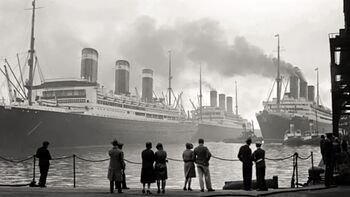Empress-Class Ocean Liner
This article is incomplete because it is pending further input from participants, or it is a work-in-progress by one author. Please comment on this article's talk page to share your input, comments and questions. Note: To contribute to this article, you may need to seek help from the author(s) of this page. |
 From left to right: Imperatrice Grigia, Imperatrice Rossa, and Imperatrice Bianca at dock in Fumicino.
| |
| Class overview | |
|---|---|
| Builders: | Royal Shipbuilders of Cacerta, Fumicino, Cacertian Empire |
| Operators: |
|
| Preceded by: | Knight-class |
| Succeeded by: | Marchioness-class |
| Built: | 1900–1906 |
| In service: | 1904–1938 |
| Planned: | 3 |
| Completed: | 3 |
| Retired: | 3 |
| General characteristics | |
| Type: | Ocean liner |
| Displacement: | 52,000 – 57,000 tons |
| Length: | 276 – 291 meters |
| Beam: | 29 – 31 meters |
| Draught: | 10 – 11 meters |
| Decks: | 11 |
| Installed power: | Varied |
| Propulsion: |
|
| Speed: | 25 knots (46 km/h) max |
| Capacity: | 3,800 – 4,300 passengers |
| Crew: | 1,100 – 1,200 crew |
The Empress-class ocean liners were a trio of Cacertian ocean liners built by the Royal Shipbuilders of Cacerta for the Empire’s White Star Line at the turn of the 20th century. The first ship, RMS Imperatrice Bianca, entered service in 1904 with the last ship, RMS Imperatrice Grigia, entering service in 1906. All three were designed to emphasized luxury and comfort and were some of the largest ocean liners to be constructed in Tyran.
All three each served for nearly three decades, garnering reputations for their services and safety records. Bianca had the distinction of serving as an Imperial Transport for the Royal House on several occasions, the Rossa ran one of the longest trans-Tyran ocean lines from Fumicino to Andria to Kenlis, and Grigia served more than four cities on her line in eastern Tyran.
Nearing the 1930s, ocean liners began receiving stiff competition from airships and long-distance aircraft which made them increasingly less profitable. Bianca would be retired from service in 1933 and later scrapped during the Siduri War. Both Rossa and Grigia would be requisitioned for service in the Cacertian Royal Navy during the conflict, serving as a troopship and hospital ship respectively. Grigia was scrapped in 1939 and Rossa followed soon after in 1940.